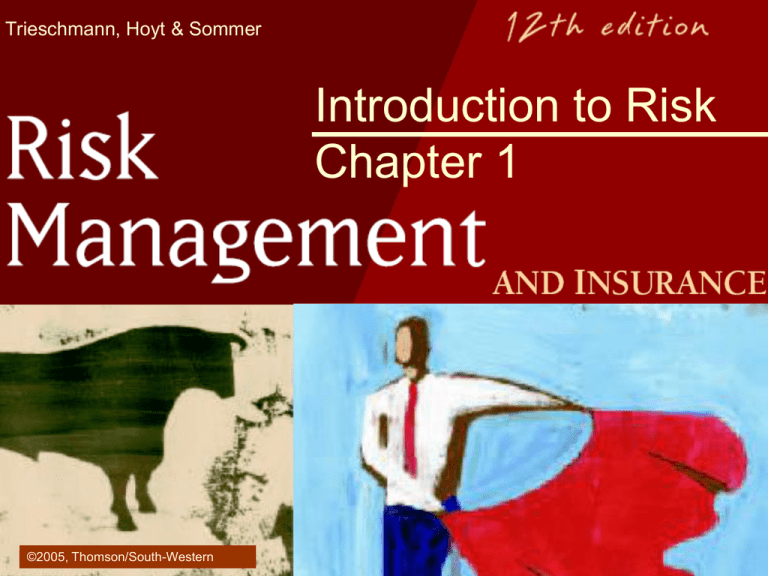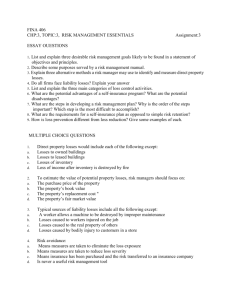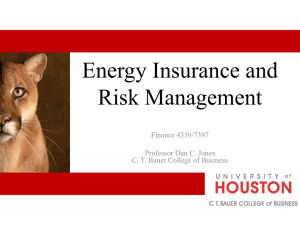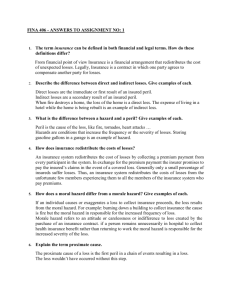Introduction to Risk Chapter 1
advertisement

Trieschmann, Hoyt & Sommer Introduction to Risk Chapter 1 ©2005, Thomson/South-Western Chapter Objectives • Explain three ways to categorize risk • List the components of an entity’s cost of risk • Give several examples of risks involving property, liability, life, health, loss of income, and financial losses • Distinguish between chance of loss and degree of risk • Give examples of three types of hazards • Identify the difference between hazards and perils • Explain the evolving concept of integrated risk management • Explain the four steps in the risk management process 2 Introduction • Risk regarding the possibility of loss can be especially problematic • If a loss is certain to occur – It may be planned for in advance and treated as a definite, known expense • When there is uncertainty about the occurrence of a loss – Risk becomes an important problem 3 The Burden of Risk • Some risks involve only the possibility of loss • Risks surrounding potential losses create significant economic burdens for businesses, government, and individuals – Billions of dollars are spent each year to finance potential losses • But when losses are not planned for in advance they may cost even more • Risk of loss may deprive society of services judged to be too risky – For instance, without malpractice insurance many physicians would refuse to practice medicine 4 The Burden of Risk • Businesses may try to either avoid risk of loss or to reduce its negative consequences • An entity’s cost of risk is the sum of – Expenses of strategies to finance potential losses – The cost of unreimbursed losses – Outlays to reduce risks – Opportunity cost of activities forgone due to risk considerations 5 FIGURE 1-1 Types of Risk 6 Pure vs Speculative Risk • Pure risk exists when there is uncertainty as to whether loss will occur • No possibility of gain is presentedonly the potential for loss • Speculative risk exists when there is uncertainty about an event that can produce either a profit or a loss • Both pure and speculative risks may be present in some situations 7 Subjective vs Objective Risk • Subjective risk refers to the mental state of an individual who experiences doubt or worry as to the outcome of a given event – It is essentially the psychological uncertainty that arises from an individual’s mental attitude or state of mind • Objective risk differs from subjective risk in the sense that it is more precisely observable and therefore measurable – It is the probable variation of actual from expected experience 8 Sources of Risk • Property risks – Risk that property may be damaged, destroyed or stolen • For example, lightning, tornadoes, hurricanes, explosions, riots, collisions, falling objects, floods, earthquakes, freezing, etc. • Liability risks – Legal judgments may result in payments made to compensate injured parties as well as to punish those responsible for the injuries • Even if the individual is absolved of liability the expenses involved in the defense may be substantial – All individuals who own or use real property are susceptible to liability losses if others are injured on their premises 9 Sources of Risk • Life and health and loss of income risks – The possibility of the untimely death of a star salesperson – The potential death of a parent with young children – Employees who become ill or injured in accidents • Financial risk – Include credit risk, foreign exchange risk, commodity risk, and interest rate risk – These risks must be identified and assessed in order for the firm to achieve its business goals 10 Measurement of Risk • Chance of loss – The long term chance of occurrence, or relative frequency of loss – Meaningful only when applied to the chance of loss occurring among a large number of possible of events • Expressed as the ratio of the number of losses that are likely to occur compared to the larger number of possible losses in a given group • Peril – Specific contingency that may cause a loss • Hazards – Conditions that exist which either increase the chance of a loss for a particular peril or tend to make the loss more severe once the peril has occurred 11 Hazards • Physical hazard – A condition stemming from the material characteristics of an object • An icy street makes the occurrence of collision more likely to occur – The icy street is the hazard and the collision is the peril • Moral hazard – Stems from an individual’s mental attitude – Associated with intentional actions designed either to cause a loss or to increase its severity – Also describes the change in attitude that can occur when insurance is available to pay for loss • Such as the tendency for individuals to consume more health care if the costs are covered by insurance • Morale hazard – The mental attitude of a careless or accident-prone person 12 Degree of Risk • Amount of objective risk present in a situation • Relative variation of actual from expected losses • Range of variability around the expected losses – Objective risk = probable variation of actual from expected losses ÷ expected losses 13 Degree of Risk • If a loss has already occurred the probable variation of actual from expected losses is zero – Therefore the degree of risk is zero • If it is impossible for loss to occur the probable variation is also zero • In measuring the degree of risk, results are meaningful only in terms of a group large enough to analyze statistically 14 Management of risk • Risk management – Process used to systematically manage risk exposures • Integrated risk management and enterprise risk management – Intent to manage all forms of risk, regardless of type • Many businesses have special departments charged with overseeing the firm’s risk management activities – The head of such a department often is called a risk manager • Some firms have formed risk management committees • Some firms have created the position of chief risk officer to coordinate the firm’s risk management activities 15 Risk Management Process • • • • Identify risks Evaluate risks Select risk management techniques Implement and review decisions 16







